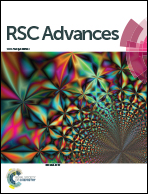Regioselective Suzuki–Miyaura reactions of 4,7-dichloro-N-methylisatin. Synthesis, anti-HIV activity and modeling study†
Abstract
Suzuki–Miyaura reactions of 4,7-dichloro-N-methylisatin provide a convenient access to arylated methylisatins. The reactions proceed with excellent site-selectivity in favour of position 4, due to electronic reasons. All the new compounds were evaluated in vitro for their antiviral activity against the replication of HIV-1 and HIV-2 in MT4 cells using a MTT assay. 4-(4-Acetylphenyl)-7-chloro-1-methylindoline-2,3-dione (8l), containing an acetyl group located at carbon C(4) of the isatin backbone, showed an IC50 value of >3.47 μM against HIV-2 with a therapeutic index (SI) of 4. This means that 8l was cytotoxic to MT-4 cells at a CC50 value of 13.43 μM; also 4,7-dichloro-1-methylindoline-2,3-dione (5), 7-chloro-4-(4-chlorophenyl)-1-methylindoline-2,3-dione (8c), 7-chloro-4-(4-ethoxyphenyl)-1-methylindoline-2,3-dione (8g) and 7-chloro-1-methyl-4-(4-vinylphenyl)indoline-2,3-dione (8m) were cytotoxic to MT-4 cells within a 2.21–3.11 μM concentration range. In a docking study, 8l interacted with several amino acids in the reverse transcriptase (RT) binding site of HIV-2.


 Please wait while we load your content...
Please wait while we load your content...